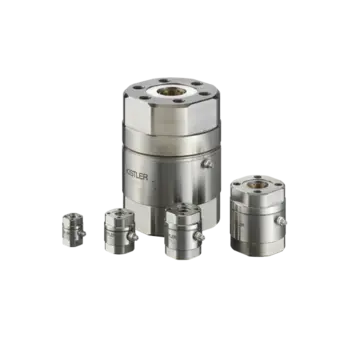Reaction torque transducers, 1-axial, Mz up to ±1000 Nm (±737 ftlb) / 93x9A

93x9A
Características/vantagens principais
- Two calibrated measuring ranges: 100%, 10%
- Very compact, ready to install reaction torque sensor
- Flexible adaption with mounting threads in double flange
- Centering seats for coaxial mounting and optimum introduction of torque
- Centric bore for shaft passage
- Can be used as torque calibration sensor
These easy to install piezoelectric reaction torque sensors are particularly suitable for measuring rapidly changing torques at non-rotating shafts. Five different size sensors are available for the measuring ranges ±1 Nm, ±10 Nm, ±25 Nm, ±200 Nm and ±1000 Nm.
The reaction torque sensor is integrated under high preload between preload screw and nut. When a torque acts on a sensor, the shear stresses produced are transmitted to the crystals. The charge signal proportional to the force is picked up by an electrode and fed through a screened cable to a charge amplifier. The charge signal is converted by the charge amplifier to a proportional output voltage, which can be recorded and evaluated.
Flanges on the top and bottom sides of the reaction torque sensor allow simple and direct installation on a shaft or adapter flange. This allows very low, space-saving installation. Alternatively, a mounting flange (optional accessories) can be used or installation can take place using custom adapters. A two-sided centering facility allows very accurate coaxial fitting. A centric bore allows additional applications, e.g. for shaft bushing. A screw-on connector cover ferrule is provided with the included accessories to protect the cable connection at the side.
Kistler reaction torque sensors reliably detect even the slightest torques acting on the sensor axis in both rotary directions.
